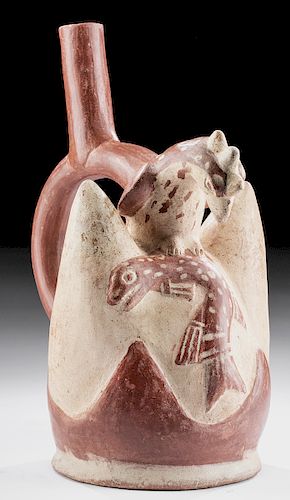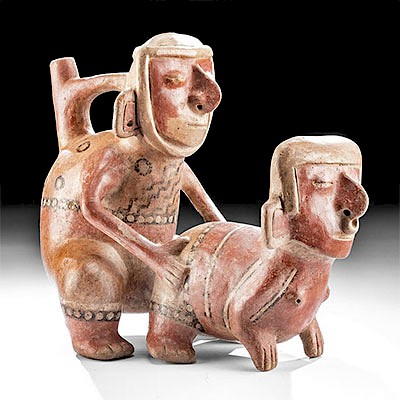Moche IV Bi-chrome Stirrup Vessel w/ Eagle and Fish
Lot 24f
About Seller
Artemis Fine Arts
686 S Taylor Ave, Ste 106
Louisville, CO 80027
United States
Selling antiquities, ancient and ethnographic art online since 1993, Artemis Gallery specializes in Classical Antiquities (Egyptian, Greek, Roman, Near Eastern), Asian, Pre-Columbian, African / Tribal / Oceanographic art. Our extensive inventory includes pottery, stone, metal, wood, glass and textil...Read more
Categories
Estimate:
$1,700 - $2,500
Absentee vs Live bid
Two ways to bid:
- Leave a max absentee bid and the platform will bid on your behalf up to your maximum bid during the live auction.
- Bid live during the auction and your bids will be submitted real-time to the auctioneer.
Bid Increments
| Price | Bid Increment |
|---|---|
| $0 | $25 |
| $300 | $50 |
| $1,000 | $100 |
| $2,000 | $250 |
| $5,000 | $500 |
| $10,000 | $1,000 |
| $20,000 | $2,500 |
| $50,000 | $5,000 |
| $100,000 | $10,000 |
| $200,000 | $20,000 |
About Auction
By Artemis Fine Arts
Jan 30, 2020
Set Reminder
2020-01-30 10:00:00
2020-01-30 10:00:00
America/New_York
Bidsquare
Bidsquare : Pre-Columbian | Tribal | Ethnographic
https://www.bidsquare.com/auctions/artemis-gallery/pre-columbian-tribal-ethnographic-4830
Featuring ancient and ethnographic art from around the world, including Pre-Columbian, Native American, African / Tribal, Oceanic, Ethnographic, Spanish Colonial, Fossils, Fine Art, much more. Artemis Fine Arts info@artemisfinearts.com
Featuring ancient and ethnographic art from around the world, including Pre-Columbian, Native American, African / Tribal, Oceanic, Ethnographic, Spanish Colonial, Fossils, Fine Art, much more. Artemis Fine Arts info@artemisfinearts.com
- Lot Description
Pre-Columbian, North Coast Peru, Moche, Phase IV, ca. 450 to 700 CE. A superb pottery stirrup vessel of impressive form and strong iconography. The highly burnished vessel is defined by a flat base, a tall body with a tapered profile and a pair of projecting conical mountain peaks, a stirrup-shaped handle with an avian-form frontal element, and a gently tapering spout. Perched atop the vessel is a highly stylized eagle in a forward-leaning pose as it admires the massive, white-spotted fish clutched within its talons above crimson waters. The Moche believed that birds were envoys between humans and the gods, so the broad flight patterns of eagles were thought to represent solar movements and thus imbued them with special powers. An attractive example of high-quality Moche artistry. Size: 7" L x 4.875" W x 9.375" H (17.8 cm x 12.4 cm x 23.8 cm)
The Chavin people lived in the northern Highland Andes, and their capital, Chavin de Huantar, is a UNESCO World Heritage Site. The artwork of Chavin represents the first widespread style in the Andes. The center of Chavin de Huantar is a massive, flat-topped pyramid, surrounded by lower platforms. Between 1200 and 500 BCE the pyramid space was used for religious ceremonies. Perhaps the mountainous peaks of this vessel reference the Andes where this monument is located, while the clear and symbolically significant avian and fish motifs may symbolize shamanism and its spiritual potency.
Provenance: private Hawaii, USA collection; ex-private Hans Juergen Westermann collection, Germany, collected from the 1950s to the 1960s
All items legal to buy/sell under U.S. Statute covering cultural patrimony Code 2600, CHAPTER 14, and are guaranteed to be as described or your money back.
A Certificate of Authenticity will accompany all winning bids.
We ship worldwide and handle all shipping in-house for your convenience.
#152631Professional repair to areas of handle and spout, and small area of restoration to front of one mountain peak, with resurfacing and overpainting along new material and break lines. Minor abrasions and nicks to base, body, eagle, handle, and spout, with fading and small areas of touch-up painting to original pigmentation, and a couple of stable hairline fissures to base and body. Light earthen deposits and nice traces of original pigment throughout. Old inventory label beneath base.Condition
- Shipping Info
-
All shipping is handled in-house for your convenience. Your invoice from Artemis Gallery will include shipping calculation instructions. If in doubt, please inquire BEFORE bidding for estimated shipping costs for individual items.
-
- Buyer's Premium



 EUR
EUR CAD
CAD AUD
AUD GBP
GBP MXN
MXN HKD
HKD CNY
CNY MYR
MYR SEK
SEK SGD
SGD CHF
CHF THB
THB
















